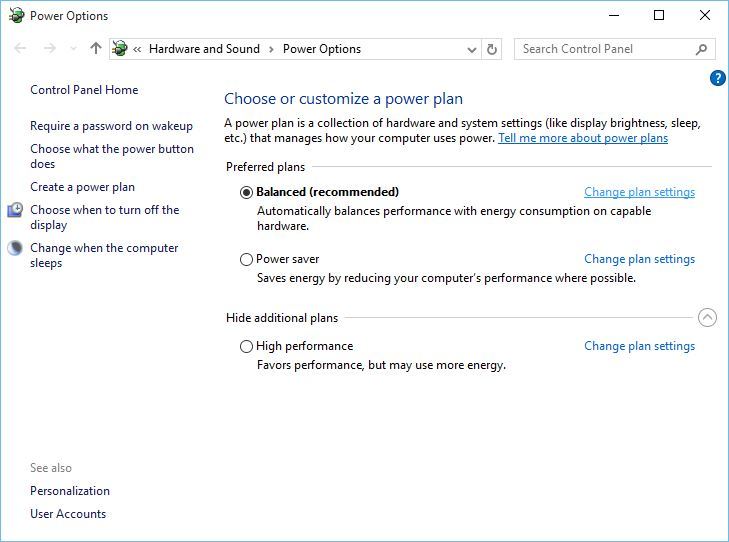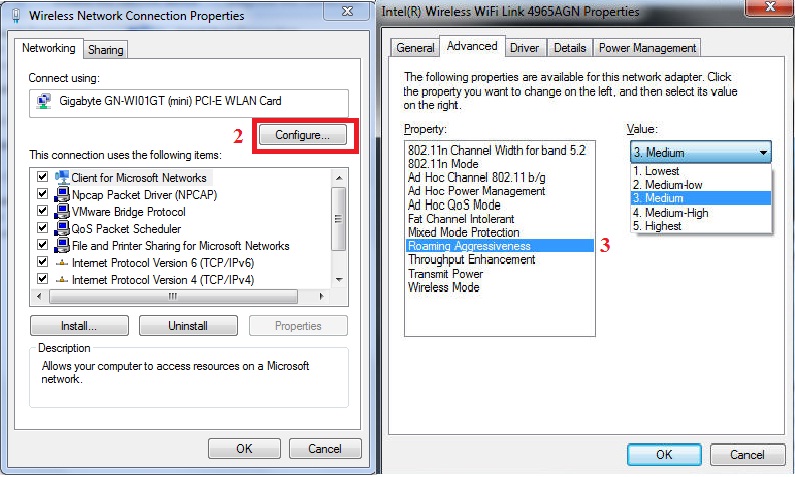Roaming Sensitivity Level Windows 10
Note: If you are interested, refer to this guide: Difference Between Public And Private Network in Windows 10. Set Low Roaming Sensitivity. Setting Low Roaming Sensitivity prevents your computer from trying to connect to other available networks. Go to Settings Network & Internet Change Adapter Options. Windows 10 Enterprise E5. The farther down the list you go, the more advanced features you receive. For example, Windows 10 Enterprise E3 and E5 include some security features that are not available in Windows Home or Pro. Below is a comparison of the security, business, and advanced features in Windows 10 Pro, Enterprise E3, and Enterprise E5. On my windows-10 laptop, it is: Antenna Diversity: Disabled (Off) Roaming Sensitivity: Low My laptop's WiFi works but has an extremely weak signal if the router is placed far off (like 2-3 rooms apart). But my smartphone and other Linux laptop has no issues in connecting the exact same router with the same distance. Jun 15, 2021 Wi-Fi Roaming Aggressiveness Setting This setting alters the signal strength threshold at which the WiFi adapter starts scanning for another candidate AP. Find this setting under the advanced adapter settings. The default value is Medium.
It can be really frustrating to work on a computer that gets frequently disconnected from WiFi Network. You will find below the steps to fix the problem of WiFi Keeps Disconnecting in Windows 10.
WiFi Keeps Disconnecting in Windows 10
The Problem of WiFi Disconnecting and connecting back again can be caused by various reasons, ranging from outdated or corrupted Network Drivers, Network Adapter getting turned OFF to other reasons.
You will find below the steps to Update Network Driver, Run the Network Troubleshooter and other methods that are known to help in fixing this problem.
1. Update Network Adapter Drivers
In many cases, the problem of WiFi disconnecting randomly can be fixed by updating Network Adapter Drivers.
1. Right click on Start button and click on Device Manager.
2. On Device Manger Screen, expand Network Adapters entry > right-click on the WiFi Adapter and click on Update Driver Software option.
Tip: If you see multiple entries, look for something that has Network, 802.11b or WiFi in it.
3. On the next screen, select Search automatically for updated driver software option and follow the on-screen prompts to install updated driver software (if available).
2. Run Internet Troubleshooter
Before moving to other methods, it is a good idea to try the built-in Troubleshooter in Windows 10 to find and fix internet connection problems on your computer.
1. Go to Settings > Update & Security.
2. On the next screen, click on Troubleshoot in the left-pane. In the right-pane, scroll down and click on Internet Connections > Run the Troubleshooter.
Note: If you do not see any Troubleshooter, scroll down and click on Additional Troubleshooters link to see all the Troubleshooters available on your computer.
3. Follow the Onscreen Instructions as Windows tries to find the fix Network connectivity issues on your computer.
3. Reset TCP/IP
1. Right-click on Start button and click on Command Prompt (Admin).
2. In Command Prompt window, type netsh winsock reset and press the Enter key.
3. Similarly, type netsh int ip reset and press the Enter key
Close the Command Prompt window, Restart your computer and see if the problem is now fixed.
4. Prevent Computer From Turning OFF WiFi Adapter
The problem of WiFi disconnecting in Windows 10 is also known to be due to the computer automatically turning OFF WiFi Adapter in order to conserve power.
1. Right-click on the Start button and click on Device Manager.
2. On Device Manger screen, expand Network Adapters entry > right-click on WiFi Adapter and click on Properties.
Tip: In case you see too many entries, look for something that says Network or 802.11b or has WiFi in it.
3. On the Properties screen, select the Power Management tab and disable Allow the computer to turn off this device to save power option.
4. Click on OK to save this setting on your computer.
Now your computer won’t be able to Turn OFF the WiFi Adapter, which should fix the problem on your computer.
5. Disable Hotspot 2.0 Networks

The WiFi Sense feature in Windows 10 is known to cause WiFi Connectivity problems.
1. Go to Settings > Network & Internet.
2. On the next screen, click on WiFi in the left-pane. In the right-pane, scroll down and disable Let me use Online Sign-up to get connected option.
Restart your computer and see if the problem of WiFi Disconnecting from your Windows 10 computer is now fixed.
Roaming Sensitivity Level Windows 10 Download


6. Connect Automatically & Make WiFi Network Private
Follow the steps below to make your computer connect automatically to Network and also make it discoverable on your Home WiFi Network.

1. Go to Settings > Network & Internet and click on your WiFi Network.
2. On the next screen, enable Connect Automatically when in range and set your WiFi Network type as Private.
Note: If you are interested, refer to this guide: Difference Between Public And Private Network in Windows 10
Tx Power Level
7. Set Low Roaming Sensitivity

Setting Low Roaming Sensitivity prevents your computer from trying to connect to other available networks.
1. Go to Settings > Network & Internet > Change Adapter Options.
2. On the next screen, right-click on your WiFi Network and click on Properties.
3. On WiFi Properties screen, click on the Configure button.
What Is Roaming Sensitivity Level
4. On the next screen, select the Advanced tab and set Roaming Aggressiveness value to Lowest or Medium-low level.
Your computer will now have a low tendency to disconnect from WiFi and try to connect to other networks.